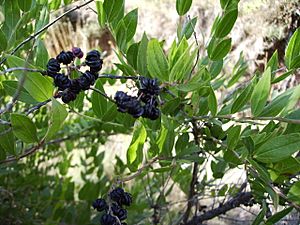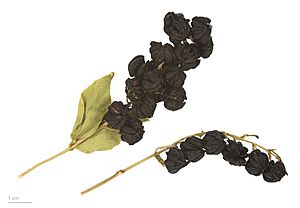Coriaria myrtifolia facts for kids
Quick facts for kids Coriaria myrtifolia |
|
|---|---|
 |
|
| Leaves and mature fruits in July | |
| Scientific classification | |
| Kingdom: | |
| Division: | |
| Class: | |
| Order: | |
| Family: | |
| Genus: | |
| Species: |
C. myrtifolia
|
| Binomial name | |
| Coriaria myrtifolia |
|
| Synonyms | |
|
C. hermaphrodita Turra |
|
Coriaria myrtifolia, also known as redoul, is a special plant. It has fruits that are not safe to eat. Its leaves were once used to make leather from animal skins. This process is called tanning.
Contents
What's in a Name?
The Spanish name for redoul is emborrachacabras. This means "making goats dizzy" or "making goats unwell." It refers to how goats might feel if they eat the leaves. The French name, redoul, and the Catalan name, roldor, come from an old Latin name. This name was used for a plant called sumac from Syria. Both plants had leaves used in the leather-making industry. Even the sweet liquid (honeydew) found on redoul can be harmful.
Plant Description
Redoul is a type of shrub that can grow up to 2 to 3 meters (about 6 to 10 feet) tall. It does not have hairs on its stems or leaves. Its leaves are shiny, much like the leaves of a myrtle plant. In fact, "myrtifolia" means "leaves like the myrtle."
The plant grows small, greenish flowers in spring, usually from April to June. These flowers grow in clusters called racemes. A raceme is a type of flower arrangement where flowers grow along a central stem.
Fruits and Seeds
Redoul plants produce fruits in early summer. These fruits look like small berries. However, they are actually tiny nuts called achenes. These achenes are protected by the plant's petals, which grow larger and become colorful. All plants in the Coriaria genus have this type of fruit. It is very important to remember that the seeds inside these fruits are not safe to eat and can make you very sick.
Special Roots
Redoul plants have a cool ability. They can take nitrogen from the air and turn it into a form the plant can use. This process is called nitrogen fixation. They do this with the help of tiny bacteria that live in their roots. This helps the plant grow strong and healthy.
Where Redoul Grows
You can find C. myrtifolia mostly around the western Mediterranean Sea. It usually grows not too far from the coast, often near rivers. Here are some of the places it grows:
- Southern Portugal
- Spain, especially along the Mediterranean coast and in Catalonia. In the Balearic Islands, it is only found on Ibiza.
- Southern France
- Italy, in the region close to France
- Morocco
- Algeria
See also
 In Spanish: Emborrachacabras para niños
In Spanish: Emborrachacabras para niños



